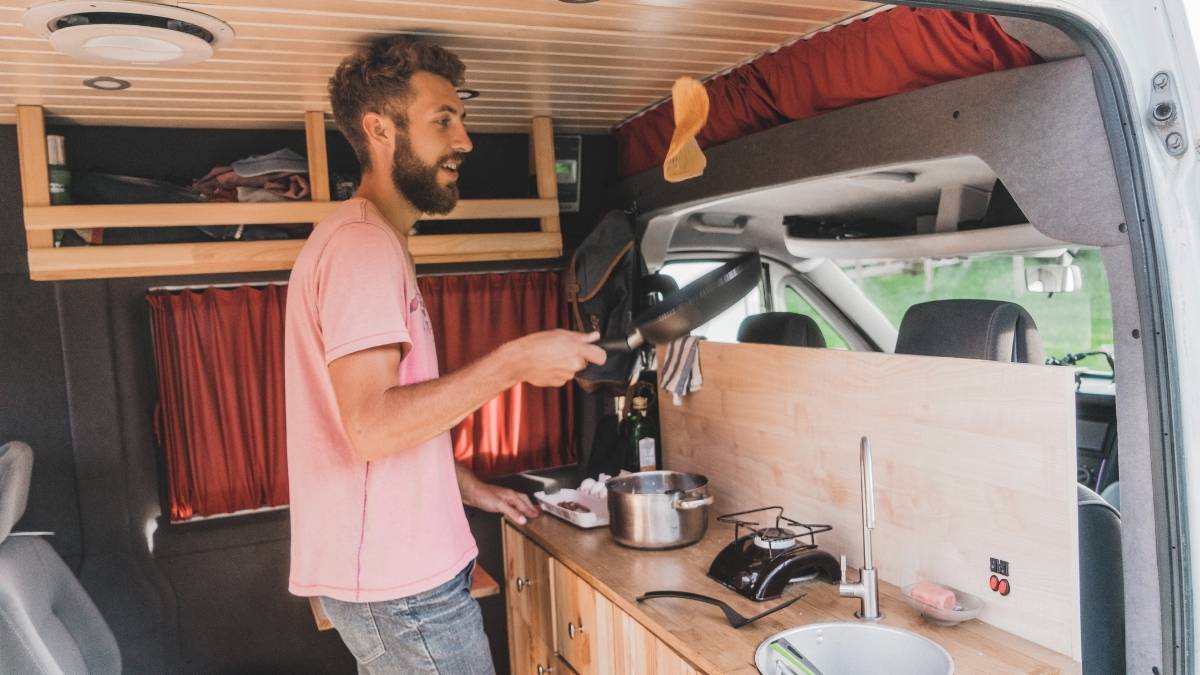In this article, we look at what we consider to be our campervan’s kitchen essentials. The campervan kitchen gadgets and cooking equipment that we always pack or live permanently in our van.
One of the absolute best things to do as campervan or motorhome owner is to have the freedom and flexibility to make a cup of tea or even a full-blown meal out in the wild should you want to.
For camping trips or day trips, having access to a couple of gas rings and a fridge is a game-changer.
But what are the kitchen essentials you need in your campervan to really own the outdoors?
We’ve listed below from our own experience and research, exactly what are must-haves in your campervan kitchen cupboards.
- Campervan cooking equipment – what to carry?
- Kitchen essential #1 – pots and pans
- Kitchen essential #2 – Kettle
- Kitchen essential #3 – cooking utensils
- Kitchen essential #4 – crockery
- Kitchen essential #5 – cutlery set
- Kitchen essential #6 – glassware
- Other handy bits to keep in your campervan kitchen
- Even more kitchen essentials?
Campervan cooking equipment – what to carry?
Space is at a premium in a campervan or motorhome.
On the other hand, you’ve chosen this style or camping because – let’s face it – camping on wheels is way more comfortable and easy than camping in tents.
So there is always that trade-off between having options to make your travel comfortable and easy, against having to store and carry yet more gear.
What exactly should you be packing? Let’s take a look at the six main types of campervan kitchen equipment that we recommend every van owner considers as essential gear.
Kitchen essential #1 – pots and pans
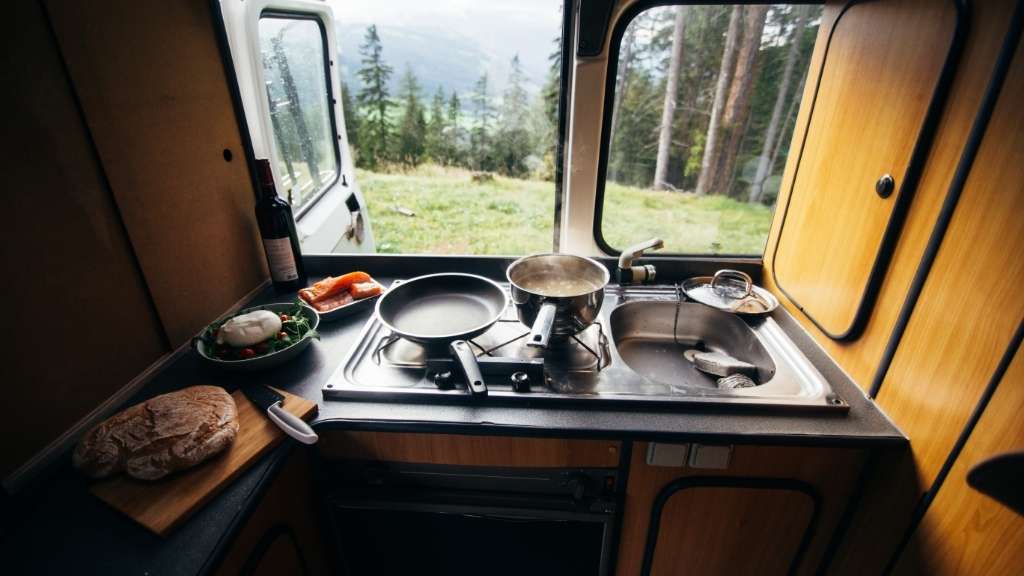
Ideally the pots and pans you choose for your campervan or motorhome should be stackable and not too big or heavy.
We recommend a set of three, four, of five pans, depending how much cooking you’re likely to do.
We have these Tefal Ingenio pans, a set of three saucepans and one frying pan with one removable handle for everything. They tick all the boxes for us:
- Affordable price.
- Made from stainless steel.
- Contain a durable non-stick coating.
- Stackable for easy campervan storage.
- Oven safe.
- Can be used on all hob types excluding induction.
- Dishwasher safe (if you want to put them in the dishwasher for a thorough washing when you get home).
Note that this pan set doesn’t come with any lids, however, Tefal does sell one specific to this set. We haven’t found this to be a big problem as we use a melamine plate as a lid and this works very well.
RidgeMonkey XL
Not exactly a pot or pan, but can act as a quasi frying pan, omelette maker, or sandwich toaster. It’s our favourite campervan kitchen gadget.
The RidgeMonkey XL comprises two hinged square pans of diecast aluminium with two magnetic handles. They come apart and can be used separately. Very clever and versatile.
Can be used on all hob types except for induction.
Kitchen essential #2 – Kettle
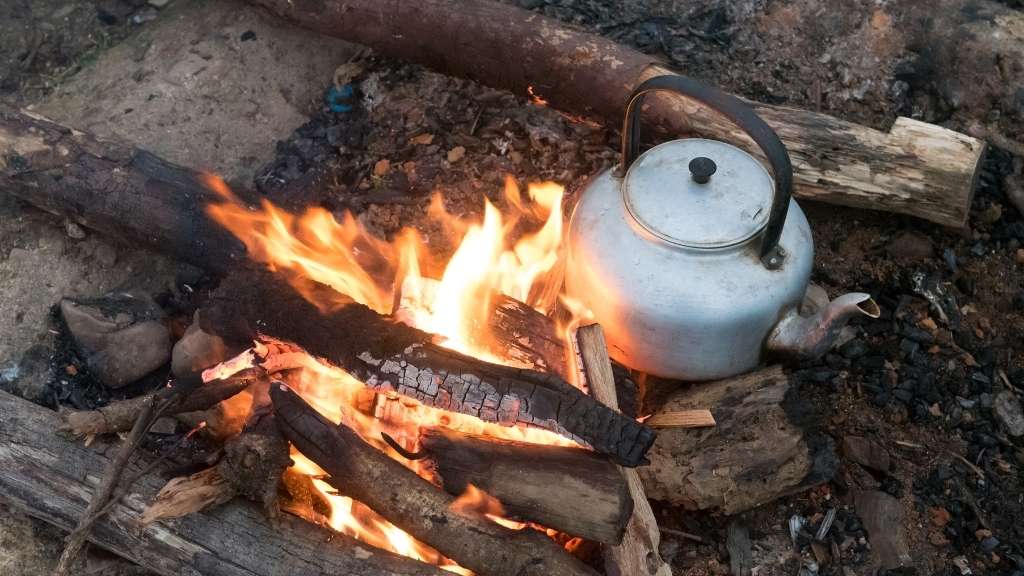
According to the UK Tea and Infusions Association, we Brits drink approximately 100 million cups of tea each day between us. Wow, we sure do like a hot beverage!
No surprise then that having a kettle in some form or another is an essential item in our campervan kitchen.
The choice of kettles to supply your campervan with comes down to the following:
- A whistling kettle – used on the hob or camping stove.
- A travel electric kettle – either with a 12V plug or UK power plug and used via an inverter or when connected to EHU.
Deciding which of these you choose hangs on whether speed is an issue. For a speedy cup of tea, you’ll be hard pressed to outperform a standard travel electric kettle. A 12V electric kettle will keep you waiting the longest with a reported 20 minutes time length to reach boiling point.
Whistling kettle
We have opted for a whistling kettle to stock our campervan, as we didn’t want to risk draining the leisure batteries too much if not on EHU and the wait time for a cup of tea is a shorter 6-8 minutes.
We can also use the kettle on our separate camping stove or a campfire.
Camping electric kettle
A standard travel electric kettle whilst smaller than a regular kettle is still quite chunky and we felt it seemed a bit cheaty for camping. We like to keep the experience a bit more camping-like in feel.
That said, I can see why people use a travel kettle and we might well make the change one day. The key benefits we can see for a travel kettle over a whistling kettle are:
- Having hot water available for a hand wash, washing up or to be used as an ingredient in something you’re cooking is very handy.
- Using up a whole gas ring to get that hot water isn’t always convenient and then you need a clear surface to move the hot kettle onto.
- Electricity is easier to source and replenish than gas.
Best whistling kettles for campervans
We have this Kampa Billy Whistling Kettle. We love it because it is:
- Small.
- Lightweight.
- 1l capacity.
- Takes 6-8 minutes to boil from cold on our campervan gas stove.
We are big fans of Kampa Dometic as a brand and highly rate the Kampa products we use. Brilliant design and innovation at an affordable price.
If the Kampa whistling kettle is a bit chunky for your campervan or motorhome kitchen cupboard, then this Outwell collapsible kettle is a fantastic alternative.
The Outwell collapsible kettle features:
- Silicone and stainless steel body.
- 14.5 x 16.5cm in size.
- Tiny pack size when collapsed – 4.5 x 16.5cm.
- 1.5L volume capacity.
- Collapsible (obviously).
- Can be used on any hob (except induction).
- BPA free.
- Dishwasher safe.
Outwell is another camping brand we love, again brilliant design and manufacture. It is a little more expensive than the Kampa Billy Whistling Kettle but does have the benefits of larger volume capacity and small pack size.
Best travel electric kettle
If speed is your game, we recommend the Kampa Squash Collapsible Electric Kettle. It’s a travel kettle and runs on a lean 1000W.
Features:
- Silicon body (food grade, high temperature resistant).
- 17 x 13 x 17.5cm when in use.
- 17 x 13 x 13 when folded.
- 800ml capacity.
- 1000W.
- 3-4 minute boil time.
Tips:
- Boil this kettle four or five times before you plan to make a cup of tea with it, to remove the silicon taste.
- Rinse with cold water once finished with it before collapsing. Should be cool enough to pack away after five minutes.
Kitchen essential #3 – cooking utensils
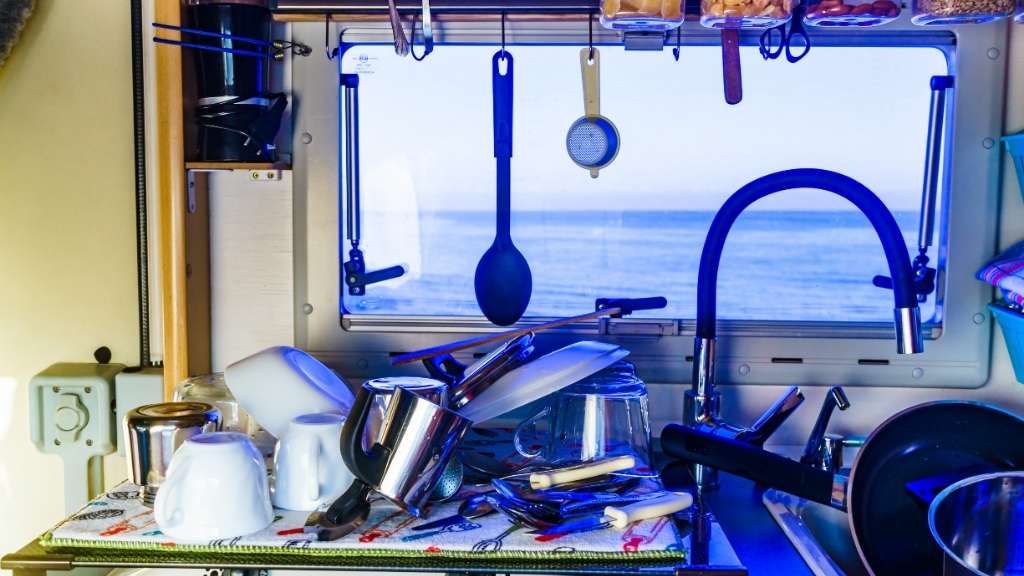
I don’t know about you, but there is a fine line between saving space and not having the tools you need to make the job easy and efficiently.
I’d rather come well armed than be left floundering.
Our inventory could no doubt be slimmed down but we do use everything in this list:
- This Sabatier knife set makes easy work of any food prep task. We personally make decent knives a must-have, it makes life so much easier.
- It’s not safe to leave sharp knives un-sheathed in a drawer. We got these knife guards to protect us from nasty knife/drawer related accidents.
- A good old fashioned three wooden spoon set.
- Oxo Good Grips Silicone Utensil Set – Great to keep your pans looking their best.
- Oxo Good Grips swivel peeler and can opener – we love the OXO Good Grips products, can’t get enough of them.
- Heavy-duty kitchen scissors with a guard.
- Joseph Joseph ‘Chop2Pot’ folding chopping board.
- Corkscrew – vital!
- Joseph Joseph space-saving grater – could they BE any cleverer?
- Wine stoppers. Keep that wine fresh and safe from spilling.
Kitchen essential #4 – crockery

Best crockery to use in a campervan
There are a few types of material to consider in selecting crockery for campervan use.
These are:
- Ceramic/Earthenware/Bone China.
- Melamine – Plastic composite.
- Corelle – Glass composite.
- Enamel.
- Bamboo.
We have chosen melamine to furnish our campervan with crockery. Our set has dinner and side plates, and small and large bowls so we have plenty to go round and not constantly washing up!
We selected melamine because it is:
- Lightweight.
- Durable and virtually unbreakable.
- Easy to clean and dishwasher safe.
I should specify and say we don’t use melamine for our mugs. We stick with ceramic as tea always tastes better out of a proper ceramic or china mug.
This melamine dinner set mimics our kitchen dinner set and adds a touch of class to the campervan kitchen.
Corelle dinner wear
Corelle is made of vitrelle tempered glass. This is created by bonding three glass layers.
Corelle, like Melamine, is very suitable for campervans due to its durability.
The main benefits of Corelle are:
- Won’t fade, stain, or chip.
- Lightweight.
- Slimline.
- Microwave, oven and dishwasher safe.
- BPA free.
- Feels like bone china.
Corelle ticks all the boxes. You get the durability of plastic, without the BPA and without the breakage. Brilliant.
It’s a little more expensive than melamine but worth investing the extra cost given all the benefits.
We’re adding this funky set to our wish list.
Enamel crockery
I have to admit, enamel plates are not my first choice, they do feel very basic. That said, they are extremely durable, practical and affordable so should not be overlooked as an option.
These ones from Falcon are a good buy.
Ceramic/bone china crockery
Not the most practical choice as a crockery solution for a campervan but still an option.
Ceramic or bone china is heavy and very likely to chip or break completely. Unless you have your crockery firmly wedged, there is a chance it could fall out when opening the door if there has been movement during transit. For the feel of bone china, consider using Corelle instead.
Bamboo crockery
Bamboo is another lightweight durable option which has the added benefit of being sustainable and eco friendly too. Also BPA free, dishwasher safe and affordable, bamboo crockery is a definite consideration for a kitchen cupboard.
This set from Vango adds a nice splash of colour to the kitchen cupboards.
Kitchen essential #5 – cutlery set
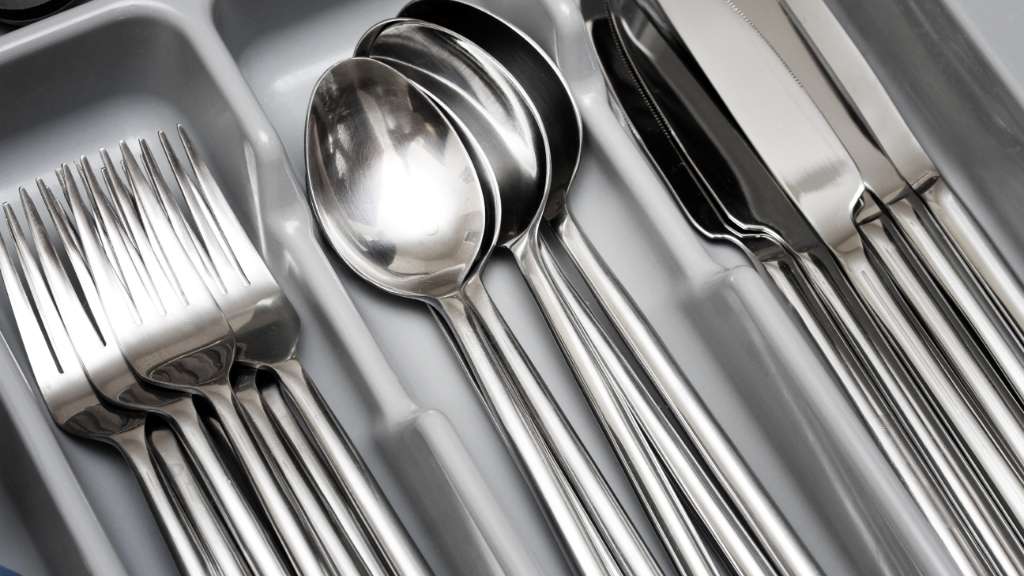
There’s no magic in selecting a cutlery set. We like to have one that is suitably dissimilar to the set we keep in the house so it is easily identifiable.
We don’t go cheap on cutlery as we want our alfresco dining experience to be as enjoyable as possible. We’re not fans of easily bendable forks and sharp edged spoons.
We would recommend a 24 piece set at least (6x 4-piece) otherwise you’re constantly washing up.
We’ve also added a few extra teaspoons as they are constantly used for cups of tea!
Kitchen essential #6 – glassware
Much like drinking tea out of plastic, we’re really also not keen on drinking wine or any other drink out of plastic.
We keep a few short glass tumblers for cold drinks. We don’t bother keeping actual wine glasses in the van, they take up too much room and are liable to break.
Stubby Holders
This is the Aussie influence in us. We love a good stubby holder – keeps the beer cold and your hand warm. We keep a ready supply of stubby holders in our campervan.
Our glass tumblers also fit inside the stubby holder meaning we can have a hot toddy without our hands getting scalded.
Other handy bits to keep in your campervan kitchen
- Cork or silicone mats. Have a stash. They are lightweight and easily transportable. If you’ve got hot pans needing to put down, have a couple within reach
- Tea towels. Pack ideally four. It can be hard to get wet linens dry again and you are washing up probably three times a day.
- Pot holders. A must-have to handle boiling pots and pans from the camping stove.
- Non-slip matting – I can’t stress how much of this stuff we use around the campervan. It’s brilliant. Stops the contents of the cupboards moving and great for when the campervan is in motion too, means you can leave things out on the kitchen top and they won’t slide. We also layer it between plates/glassware to stop rattling and movement.
Even more kitchen essentials?
We’ve enjoyed digging through our campervan kitchen to find the equipment that we’ve found to be indispensable. We hope this list is useful for you too.
If you have any other gear that you consider to be essential in your campervan kitchen then do let us know – we’d love to hear from you.
Related article: What to Pack for a Campervan Trip (Complete Packing List)
